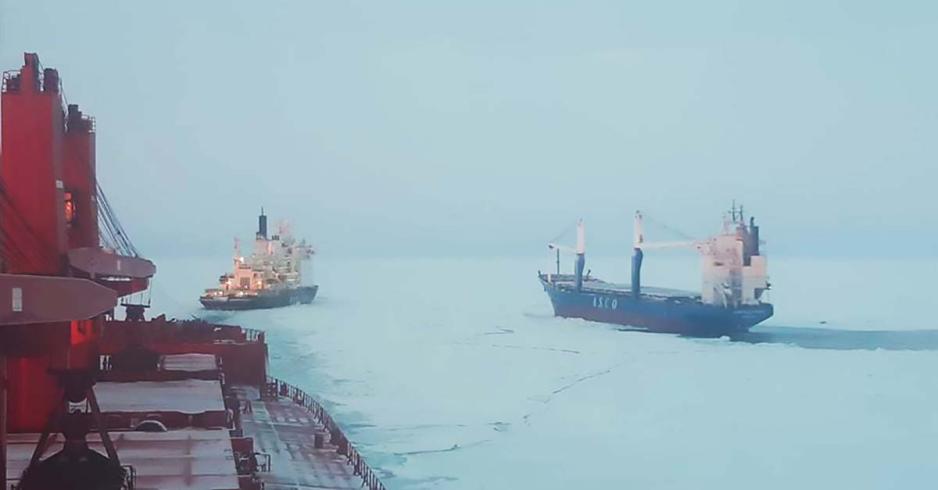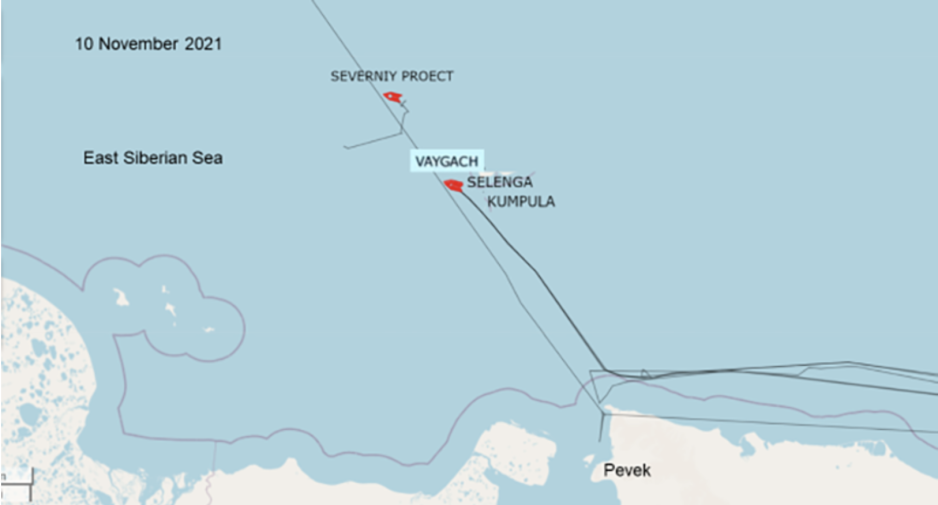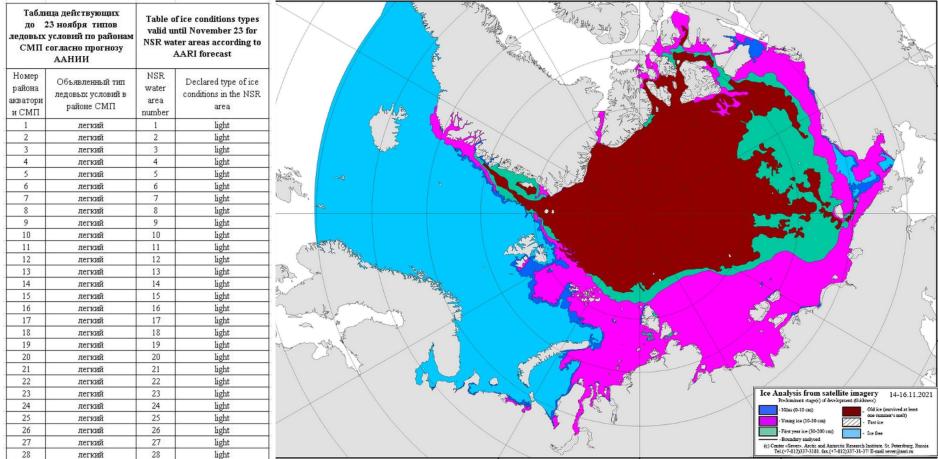Early Winter Freeze Traps Ships in Arctic Ice, Highlighting Weak Safety Regime

Ice-strengthened supramax Kumpula (Arc 4) on the NSR being escorted by nuclear icebreaker Vaygach. (Source: Courtesy of ESL Shipping)
Early season sea ice has stranded two dozen ships along Russia’s Northern Sea Route. The latest incident raises questions if the current rules of navigation are sufficient to ensure safety as more and more ships travel along the sea route.
For the past four weeks 24 ships have struggled to travel through thick sea ice along the eastern section of Russia’s Northern Sea Route (NSR). Unusually heavy traffic for this time of year, unseasonably challenging ice conditions, and only a single nuclear icebreaker, Vaygach, available for escorts meant that some ships were stuck in sea ice for weeks before receiving an icebreaker escort.
The events raise larger questions about ice class requirements on the route and the roles of the NSR Administration office (NSRA) and Rosatom, provider of nuclear icebreaker service, in ensuring safety of navigation during times of rapidly changing ice conditions.
“I think there is negligence on the part of the NSRA authorities. All the cargo ships that are stuck in the ice have a very low ice class, or none at all. And the authorities let them pass,” explains Hervé Baudu, Chief Professor of Maritime Education at the French Maritime Academy (ENSM).
“I think that the authorities should have prohibited navigation in an ice pack that closed very early in the season. I also think that convoys should have been organized rather than each ship sailing independently,” Baudu continued.
According to Alexey Likhachev, Director General of Rosatom, the current situation will not be resolved until the end of December despite extensive coordination to free vessels as quickly as possible.
The latest incident occurs against the backdrop of ambitious targets for growing cargo volume on the route. According to shipping experts there likely exists ongoing pressure from the Kremlin to reach President Putin’s goal of expanding traffic to reach 80m tons in 2024 and safety concerns may take a back seat to economic considerations.
Do the current rules of navigation for the NSR, which became less stringent when ice-class requirements were reduced in 2020, provide adequate safety margins?
Vessels encounter early season ice
The current situation began around October 25th, according to Nord University’s Center for High North Logistic (CHNL), which has closely followed the situation unfold. A detailed report is available on the Center’s website.
In short, over the past month a total of 24 vessels travelling along the route – either delivering cargo to local ports or transiting the NSR as a sort of shortcut between Europe and Asia – became stuck in sea ice and required icebreaker assistance.

The situation on November 10 according to the CHNL. (Source: Courtesy of CHNL)
During the winter navigation season four nuclear icebreakers operate along different sections of the route to escort ships through the ice. However, several icebreakers, including Yamal and 50 Let Pobedy, were still docked in Murmansk when ice conditions worsened. Rosatom is constructing a new generation of nuclear icebreakers but their launch has seen ongoing delays.
This left Vaygach as the only icebreaker along a 2000 nautical mile section of the NSR to assist vessels in trouble. The report by CHNL shows Vaygach traveling back and forth along vast swaths of the route trying to escort ships and corral them into convoys. Finally on November 16 a second nuclear icebreaker, Yamal, departed Murmansk to provide additional assistance.
A history of safety violations
The NSR has seen a number of well-documented safety issues primarily related to ice-class violations over the past few years. For example, last winter an Arctic cargo ship, Sparta III, violated safety rules and sailed into unsafe ice conditions. It took nearly four weeks, several icebreakers and rescue ships to escort it to safety.
In 2018 the liquefied natural gas (LNG) Carrier Boris Vilkitsky entered the NSR despite one of its two engines being damaged, violating the rules of navigation.
In the past the NSRA carefully recorded each violation – in 2017 alone it reported more than 100 safety violations – but it stopped publishing a list of incidents in 2018.
At least three of the vessels currently stuck on the NSR possess only minimal ice-strengthening of classes Ice-2 and Ice-3. The level of protection against ice is in fact so limited that the NSR rules prohibit these types of ships from sailing anywhere along the route after November 15.
While the ships’ original itineraries may have put them clear of the NSR before the middle of November, their late-season journeys left no room for delays. As of November 15 all three ships are in violation of the rules of navigation of the NSR.
Lack of accurate ice forecasts
Of far greater concern than the violation of safety rules by individual vessels may be systemic issues either failing to correctly forecast ice conditions and relaying information to vessels on the route, or purposefully downplaying ice conditions as to not discourage shipping activity.
“Navigation on the margins of the summer season is not just a matter of the ice class of the ships. In the case of the ships that got stuck in the ice, it is more a question of anticipating the ice conditions. Certainly, the ships are not well enough informed about the evolution of the ice drift but also about the reconstitution of the new ice at the beginning of the winter. However, this is the job of the NSRA operational center,” elaborates Baudu.
The Ministry for the Development of the Russian Far East also noted that the current situation was caused by an incorrect forecast of the ice situation.
According to the NSRA’s ice condition report light ice conditions can be found along the entire NSR. However, even in light ice conditions floes can collide and form compression ridges that can be several meters high. It is more the pressure of the ice pack than its thickness that traps the ships, says Baudu. Ice charts also show up to 70cm thick one-year ice and even thicker multi-year ice, along at least parts of the East Siberian Sea.

Ice conditions along the NSR according to the NSRA and the Arctic and Antarctic Research Institute. (Source: NSRA and AARI)
Is safety taking a back seat?
The liberal interpretation of the rules of navigation and not discouraging or prohibiting vessels from entering the route when conditions are marginal may be intended to not stifle growing shipping activity. After all, President Putin has repeatedly announced an ambitious goal of reaching 80m tons by 2024, compared to around 35m tons today.
In a similar vein, new ice-class requirements, which entered into effect in 2020, reduced the need for icebreaker escorts for Arc-4, Arc-5 and Arc-6 vessels allowing these medium ice-strengthened ships to travel the route longer into winter season and early during summer season.
According to Baudu habits and traditional shipping practices Russian ships and captains have engaged in for decades could also play a role. “These are Russian cargo ships, many of them are 30 years old on average. I think these are their habits.”
However, with rapidly increasing traffic volume along the route the stakes, from a safety perspective, have certainly been raised calling into question the NSRA’s ability to manage the route safely and efficiently.
“It is certain that this is not a good advertisement for NSRA (and Rosatom) which provides assistance, escort, and information on navigation conditions to shipowners,” concludes Baudu.



